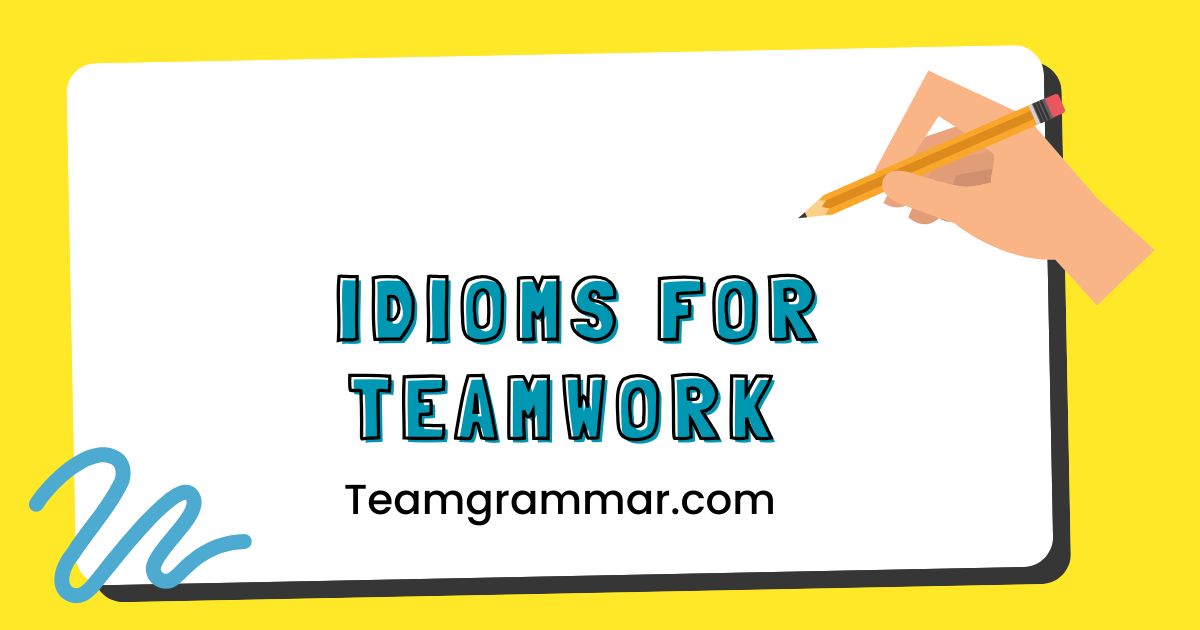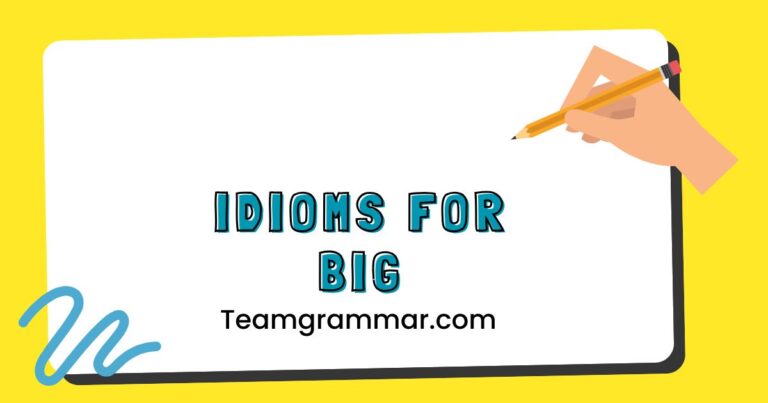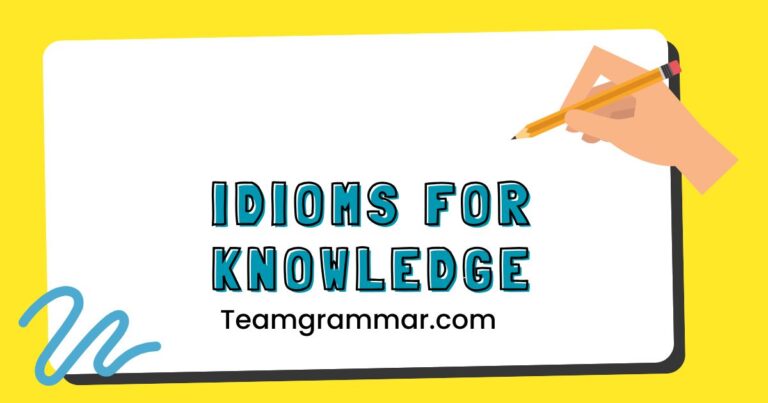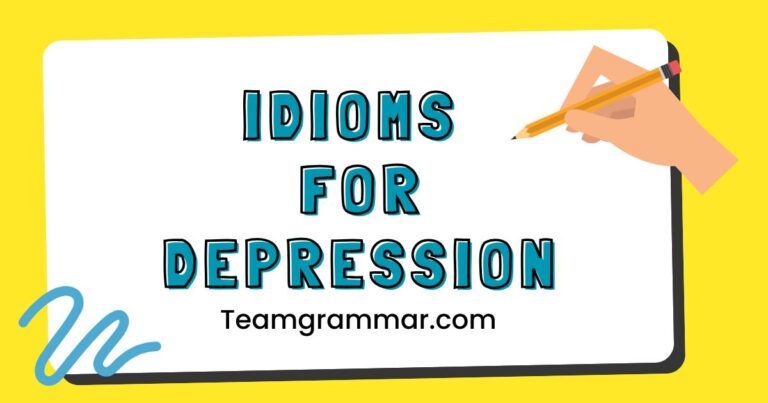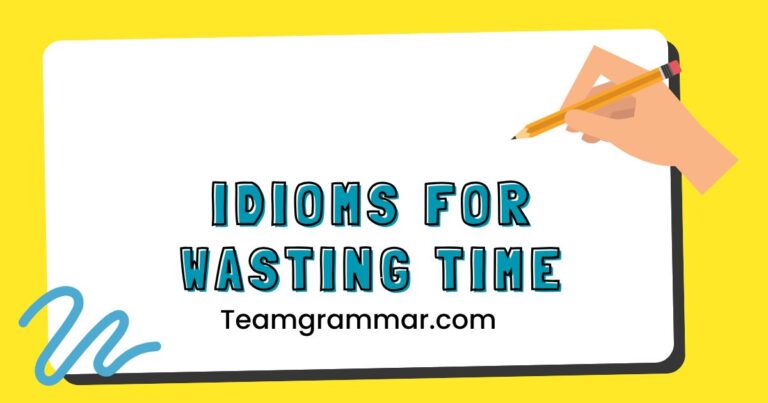40 Idioms for Teamwork: Mastering Collaborative English
Understanding and using idioms related to teamwork can significantly enhance your communication skills, especially in professional and collaborative environments. These expressions, often colorful and metaphorical, provide a shorthand way to convey complex ideas about cooperation, shared goals, and mutual support.
Mastering teamwork idioms not only improves your comprehension of spoken and written English but also allows you to express yourself more eloquently and impactfully. This guide is designed for English language learners, professionals, and anyone seeking to improve their communication skills in team-oriented settings, offering a comprehensive exploration of common idioms, their meanings, and practical applications.
Table of Contents
- Introduction
- Definition of Idioms for Teamwork
- Structural Breakdown
- Types and Categories of Teamwork Idioms
- Examples of Teamwork Idioms
- Usage Rules for Teamwork Idioms
- Common Mistakes with Teamwork Idioms
- Practice Exercises
- Advanced Topics
- FAQ
- Conclusion
Introduction
Effective teamwork is crucial in various aspects of life, from workplace collaborations to community projects. Idioms related to teamwork offer a unique and colorful way to express the dynamics, challenges, and successes inherent in collaborative efforts.
Understanding these idioms allows for clearer and more nuanced communication, fostering better relationships and more productive outcomes. This article will delve into the world of teamwork idioms, providing definitions, examples, usage rules, and practice exercises to help you master this essential aspect of English communication.
Definition of Idioms for Teamwork
An idiom is a phrase or expression whose meaning cannot be understood from the ordinary meanings of the words within it. Instead, the idiom has a figurative meaning that is understood culturally.
Idioms related to teamwork specifically refer to expressions that describe collaborative efforts, shared goals, and the dynamics of working together. These idioms often highlight the importance of cooperation, communication, and mutual support in achieving common objectives.
Classification: Teamwork idioms fall under the broader category of figurative language, specifically idioms. They are a subset that focuses on the context of collaboration and group dynamics.
Function: The primary function of teamwork idioms is to convey complex ideas about collaboration in a concise and memorable way. They add color and emphasis to communication, making it more engaging and impactful.
Contexts: Teamwork idioms are commonly used in business settings, project management discussions, sports commentary, and everyday conversations when referring to cooperative efforts. They can be found in written and spoken English, including reports, presentations, meetings, and casual discussions.
Structural Breakdown
The structure of idioms can vary greatly. Some idioms are phrases, while others are complete sentences.
Understanding the structure of an idiom is less about grammatical analysis and more about recognizing the phrase as a single unit with a specific, non-literal meaning. Here are a few structural patterns commonly found in teamwork idioms:
- Phrasal Verbs: Many teamwork idioms incorporate phrasal verbs (verb + preposition/adverb). For example, “pitch in” (to contribute) and “pull together” (to cooperate).
- Metaphorical Language: Teamwork idioms often use metaphors to represent collaborative concepts. For example, “rowing in the same boat” uses the image of rowing to symbolize shared effort.
- Similes: Some idioms employ similes (comparisons using “like” or “as”). Although less common, they can effectively convey teamwork dynamics.
- Fixed Expressions: Many idioms are fixed expressions, meaning the words cannot be changed without altering the meaning or making the idiom nonsensical.
It’s crucial to recognize that the individual words in an idiom do not contribute to its overall meaning in a literal way. The entire phrase must be understood as a single, indivisible unit.
Types and Categories of Teamwork Idioms
Teamwork idioms can be categorized based on the aspect of collaboration they emphasize. Here are a few key categories:
Idioms Emphasizing Cooperation
These idioms highlight the importance of working together harmoniously.
Idioms Emphasizing Shared Goals
These idioms focus on the alignment of objectives and the pursuit of a common purpose.
Idioms Emphasizing Contribution
These idioms describe the act of contributing effort and resources to a team.
Idioms Emphasizing Support
These idioms highlight the importance of providing assistance and encouragement to team members.
Idioms Emphasizing Conflict Resolution
These idioms address the handling of disagreements and challenges within a team.
Examples of Teamwork Idioms
Here are several examples of teamwork idioms, categorized by the aspect of teamwork they emphasize. Each example includes the idiom, its meaning, and a sample sentence.
Examples Emphasizing Cooperation
The following table illustrates idioms that emphasize cooperation within a team setting.
| Idiom | Meaning | Example Sentence |
|---|---|---|
| Pull Together | Work hard as a team to achieve something. | Despite the initial setbacks, the team managed to pull together and deliver the project on time. |
| Row in the Same Boat | Be in the same difficult situation. | We are all rowing in the same boat during this economic downturn, so we need to support each other. |
| On the Same Page | In agreement or understanding. | Before we start the project, let’s make sure everyone is on the same page regarding the goals and objectives. |
| Two Heads Are Better Than One | Two people working together can solve a problem more easily than one person working alone. | I was stuck on this problem, but then I remembered that two heads are better than one, so I asked my colleague for help. |
| Join Forces | Combine efforts to achieve a common goal. | The two companies decided to join forces to develop a new technology. |
| Work Hand in Glove | Work very closely and harmoniously. | The marketing and sales teams work hand in glove to ensure a successful product launch. |
| In Concert | Acting together; in agreement. | The departments acted in concert to streamline the process and improve efficiency. |
| Sing from the Same Hymn Sheet | To express the same opinion or belief as other people. | It’s important that everyone on the team sings from the same hymn sheet when talking to clients. |
| Be of One Mind | To have the same opinion or aim. | The board members were of one mind when they decided to invest in the new project. |
| In Sync | Working well together. | The dancers were perfectly in sync during the performance. |
| Side by Side | Working closely together. | The two engineers worked side by side to troubleshoot the software issue. |
| In League With | Working together, often secretly. | The two companies were in league with each other to manipulate the market prices. |
| Hand in Hand | Working together supportively. | The community and the local government worked hand in hand to revitalize the neighborhood. |
| On the Same Wavelength | Having the same ideas and opinions. | It’s great when you’re on the same wavelength as your colleagues; it makes collaboration much easier. |
| All in the Same Boat | In the same difficult situation. | During the recession, we were all in the same boat, trying to keep our businesses afloat. |
| United Front | Acting as a unified group. | The employees presented a united front when negotiating with management. |
| Shoulder to Shoulder | Standing or working close together in support. | The soldiers fought shoulder to shoulder to defend their country. |
| In Unison | Acting or speaking together. | The choir sang in unison, creating a beautiful and harmonious sound. |
| Birds of a Feather Flock Together | People who are similar tend to associate with each other. | Birds of a feather flock together; that’s why the members of the club get along so well. |
| One for All, All for One | Everyone supports everyone else in a group. | The team’s motto was one for all, all for one, reflecting their commitment to mutual support. |
| Get Along | To have a good relationship. | The team members get along very well, which makes working together much more enjoyable. |
| See Eye to Eye | To agree with someone. | It’s important for the team to see eye to eye on the project’s objectives. |
| Be a Team Player | To work well with others. | John is a great team player, always willing to help out his colleagues. |
Examples Emphasizing Shared Goals
The following table illustrates idioms that emphasize shared goals within a team setting.
| Idiom | Meaning | Example Sentence |
|---|---|---|
| Keep Your Eye on the Ball | Stay focused on the main goal. | It’s easy to get distracted, but we need to keep our eye on the ball and finish the project on time. |
| Aim High | Set ambitious goals. | The company encourages its employees to aim high and strive for excellence. |
| Reach for the Stars | Try to achieve something very difficult. | Don’t be afraid to reach for the stars; you might be surprised at what you can achieve. |
| On Target | Making good progress towards a goal. | The project is on target to be completed by the end of the month. |
| Hit the Mark | Achieve the desired result. | The marketing campaign hit the mark, resulting in a significant increase in sales. |
| Head in the Right Direction | Moving towards the correct goal. | Although we still have a long way to go, we’re headed in the right direction. |
| Keep the End in Mind | Remember the ultimate goal. | When facing challenges, it’s important to keep the end in mind and stay motivated. |
| Have a Common Goal | Share the same objective. | The team members have a common goal: to improve customer satisfaction. |
| Work Towards a Common Goal | Collaborate to achieve a shared objective. | The departments work towards a common goal: to increase company revenue. |
| With a View to | With the intention of achieving something. | The company invested in new technology with a view to improving efficiency. |
| Set Your Sights On | To have something as a goal. | She set her sights on becoming the CEO of the company. |
| Have a Target in Mind | To have a specific goal. | The sales team has a target in mind for the end of the quarter. |
| Aim For the Top | Strive for the highest level of success. | The company encourages its employees to aim for the top in their careers. |
| Keep Your Eyes on the Prize | Stay focused on the ultimate reward or goal. | Despite the challenges, the athletes kept their eyes on the prize and won the championship. |
| Go the Extra Mile | Do more than what is expected. | He always goes the extra mile to ensure the project’s success. |
| On Track | Making good progress. | The project is on track to be completed by the deadline. |
| In Pursuit Of | Trying to achieve something. | The company is in pursuit of new markets to expand its business. |
| Within Striking Distance | Close to achieving a goal. | The team is within striking distance of reaching its sales target. |
| Climbing the Ladder | Advancing in a career or organization. | She’s been climbing the ladder steadily since joining the company. |
| Make Headway | Make progress. | The team is making headway on the research project. |
| Get the Ball Rolling | Start something. | Let’s get the ball rolling on this project by scheduling a kickoff meeting. |
| Lay the Groundwork | Prepare for something. | The team worked hard to lay the groundwork for the new marketing campaign. |
| Set the Stage | Prepare the circumstances for something to happen. | The CEO’s speech set the stage for the company’s new direction. |
Examples Emphasizing Contribution
The following table illustrates idioms that emphasize contribution within a team setting.
| Idiom | Meaning | Example Sentence |
|---|---|---|
| Pitch In | Contribute to a task or activity. | Everyone needs to pitch in to get the project done on time. |
| Do Your Part | Fulfill your responsibility. | Make sure you do your part to ensure the team’s success. |
| Carry Your Weight | Do your fair share of the work. | It’s important that everyone carries their weight on the team. |
| Pull Your Weight | Do your fair share of the work. | If you don’t pull your weight, the team will suffer. |
| Chip In | Contribute something, often money. | We all chipped in to buy a gift for our retiring colleague. |
| Add Fuel to the Fire | Make a situation worse. | His comments only added fuel to the fire during the heated debate. |
| Put Your Shoulder to the Wheel | Work hard to achieve something. | We need to put our shoulder to the wheel to meet the deadline. |
| Go the Extra Mile | Do more than what is expected. | She always goes the extra mile to ensure the customer is satisfied. |
| Give It Your All | Put in maximum effort. | We need to give it our all to win the competition. |
| Go All Out | Make a maximum effort. | The team went all out to prepare for the presentation. |
| Put Your Heart Into It | Do something with great enthusiasm and dedication. | If you put your heart into it, you can achieve anything. |
| Make a Contribution | Offer something valuable. | His experience made a significant contribution to the project’s success. |
| Play a Part | Contribute to something. | Everyone on the team played a part in the successful product launch. |
| Be Instrumental In | To be very important in helping something to happen. | His leadership was instrumental in the team’s success. |
| Have a Hand In | To be involved in something. | She had a hand in designing the new website. |
| Throw Your Hat in the Ring | To announce your candidacy or willingness to participate. | He decided to throw his hat in the ring for the leadership position. |
| Do Your Bit | To make a contribution. | Everyone needs to do their bit to help the community. |
| Take the Plunge | To commit to something. | They decided to take the plunge and start their own business. |
| Make an Input | Provide ideas and suggestions. | The team members were encouraged to make an input during the brainstorming session. |
| Bring to the Table | Offer a valuable skill or asset. | Each team member brings unique skills to the table. |
| Add Value | Increase the worth of something. | Her expertise added value to the project. |
| Be a Driving Force | To be the person who encourages a particular activity or development and makes sure that it is done properly. | He was a driving force behind the company’s success. |
| Be a Key Player | To be one of the most important people involved in something. | She is a key player on the team. |
Examples Emphasizing Support
The following table illustrates idioms that emphasize support within a team setting.
| Idiom | Meaning | Example Sentence |
|---|---|---|
| Have Someone’s Back | Support and protect someone. | I always have my colleague’s back during difficult situations. |
| Stand by Someone | Support someone in a difficult situation. | The team stood by their leader during the crisis. |
| Back Someone Up | Support or assist someone. | I’ll back you up in the meeting if you need it. |
| Lend a Hand | Help someone. | Can you lend me a hand with this report? |
| Give a Helping Hand | Offer assistance. | She’s always willing to give a helping hand to her colleagues. |
| Be There For Someone | Be available to support someone. | I know I can always be there for my team members when they need me. |
| Pick Up the Slack | Take on extra work when someone is unable to do their part. | When John was sick, the rest of the team picked up the slack. |
| Go to Bat For Someone | Support or defend someone. | The manager went to bat for his employee when he was unfairly accused. |
| Be in Someone’s Corner | Support someone. | I’m always in your corner, no matter what. |
| Be a Shoulder to Cry On | Offer support and sympathy. | She’s always a shoulder to cry on when I’m feeling down. |
| Stand Shoulder to Shoulder | To support each other. | The community stood shoulder to shoulder to protest the new development. |
| Rally Around | To come together to support someone. | The employees rallied around their boss after his accident. |
Usage Rules for Teamwork Idioms
Using idioms correctly requires understanding their context and intended meaning. Here are some general rules to follow:
- Understand the Meaning: Before using an idiom, ensure you fully understand its meaning and connotations.
- Consider the Audience: Be mindful of your audience and their familiarity with idioms. Avoid using obscure or culturally specific idioms that may not be understood.
- Use Appropriately: Use idioms in situations where they enhance communication and add emphasis. Avoid using them excessively, as this can make your language sound unnatural or forced.
- Maintain Consistency: Do not mix idioms or alter their structure. This can lead to confusion and misinterpretation.
- Pay Attention to Tone: Idioms can convey different tones, from informal to humorous. Choose idioms that are appropriate for the context and your intended message.
Common Mistakes with Teamwork Idioms
Here are some common mistakes to avoid when using teamwork idioms:
- Literal Interpretation: Interpreting idioms literally instead of understanding their figurative meaning.
- Misusing Idioms: Using an idiom in the wrong context or with an incorrect meaning.
- Mixing Idioms: Combining parts of different idioms, resulting in nonsensical expressions.
- Overusing Idioms: Using too many idioms in a single conversation or piece of writing, making the language sound unnatural.
Example of Incorrect Usage:
Incorrect: “Let’s keep our eyes on the prize and pull our legs.” (Mixing “keep your eye on the prize” and “pull someone’s leg”)
Correct: “Let’s keep our eyes on the prize and stay focused on our goal.”
Practice Exercises
Complete the following sentences using appropriate teamwork idioms from the examples provided earlier.
Exercise 1
| Question | Answer |
|---|---|
| 1. Despite our differences, we need to ______ to achieve our shared goals. | pull together |
| 2. It’s important that everyone ______ and contributes to the project. | pitches in |
| 3. We need to ______ and focus on what matters most. | keep our eye on the ball |
| 4. If you need help, don’t hesitate to ask; I’m always here to ______. | lend a hand |
| 5. During the economic crisis, we were all ______. | rowing in the same boat |
| 6. The team members ______ to finish the project on time. | worked hand in glove |
| 7. She always ______ to ensure her customers are satisfied. | goes the extra mile |
| 8. The company encouraged its employees to ______ and strive for excellence. | aim high |
| 9. The team ______ when one of the members fell ill. | picked up the slack |
| 10. It’s important for the team to ______ on the project’s objectives. | see eye to eye |
Exercise 2
| Question | Answer |
|---|---|
| 1. The two companies decided to ______ to develop a new product. | join forces |
| 2. Let’s make sure everyone is ______ before we start the project. | on the same page |
| 3. He’s always willing to ______ and help out his colleagues. | be a team player |
| 4. The dancers were perfectly ______ during the performance. | in sync |
| 5. During the negotiation, the employees presented a ______. | united front |
| 6. She ______ and became the CEO of the company. | climbed the ladder |
| 7. His leadership was ______ in the team’s success. | instrumental in |
| 8. The CEO’s speech ______ for the company’s new direction. | set the stage |
| 9. We need to ______ on this project by scheduling a kickoff meeting. | get the ball rolling |
| 10. The team is ______ of reaching its sales target. | within striking distance |
Advanced Topics
For advanced learners, exploring the nuances of idioms, understanding their origins, and recognizing their cultural significance can further enhance their understanding. Additionally, analyzing how idioms are used in literature and media can provide deeper insights into their impact and effectiveness.
Consider researching the etymology of specific teamwork idioms to gain a better appreciation for their historical and cultural context.
FAQ
- What is the difference between an idiom and a proverb?
An idiom is a phrase whose meaning is not predictable from the usual meanings of its constituent elements. A proverb is a short, well-known saying that expresses a general truth or piece of advice. While both are types of figurative language, proverbs often offer wisdom or guidance, while idioms are more about conveying meaning in a non-literal way.
- How can I improve my understanding of idioms?
Immerse yourself in the language by reading books, watching movies, and listening to podcasts in English. Pay attention to how native speakers use idioms in conversation and try to incorporate them into your own speech and writing. Use online resources and idiom dictionaries to look up unfamiliar expressions.
- Is it okay to use idioms in formal writing?
It depends on the context and audience. In general, it’s best to avoid using idioms in highly formal or academic writing, as they can be seen as informal or colloquial. However, in less formal settings, such as business reports or presentations, using idioms can add color and emphasis to your message.
- How do I know when to use an idiom?
Consider the purpose of your communication and the effect you want to create. Idioms are best used when you want to convey a complex idea in a concise and memorable way. They can also add humor or personality to your language. However, avoid using idioms if you are unsure of their meaning or if they are not appropriate for the context.
- Can idioms be translated literally?
No, idioms cannot be translated literally. Because their meaning is figurative and culturally specific. A literal translation will likely result in a nonsensical or incorrect interpretation. It’s important to understand the intended meaning of the idiom and find an equivalent expression in the target language.
- Are there regional variations in idioms?
Yes, there are regional variations in idioms. Some idioms are specific to certain countries or regions, while others have different meanings or usages depending on the location. Be aware of these variations and use idioms that are appropriate for your audience.
- How can I avoid misusing idioms?
Double-check the meaning and usage of an idiom before using it. Use online resources and idiom dictionaries to confirm that you are using it correctly. Pay attention to how native speakers use the idiom in conversation and writing. If you are unsure, it’s best to avoid using the idiom altogether.
- What are some common resources for learning idioms?
There are many online resources for learning idioms, including idiom dictionaries, websites, and apps. You can also find idioms in books, movies, and TV shows. Some popular resources include the Oxford Idioms Dictionary, the Cambridge Idioms Dictionary, and websites like UsingEnglish.com.
- Can I create my own idioms?
While it is possible to create new expressions, they are not considered idioms until they are widely adopted and understood by a community of speakers. Idioms gain their meaning through cultural consensus and repeated use. Creating your own expressions can be a fun exercise, but they may not be understood by others.
- How important is it to learn idioms for fluency in English?
Learning idioms is very important for achieving fluency in English. While you can communicate effectively without using idioms, understanding and using them will make your language sound more natural and expressive. It will also help you better understand native speakers and their cultural references.
Conclusion
Mastering idioms related to teamwork is essential for effective communication in collaborative settings. By understanding the meanings, usage rules, and common mistakes associated with these expressions, you can enhance your ability to express complex ideas and build strong relationships with your colleagues.
Remember to practice using these idioms in your everyday conversations and writing to reinforce your learning and improve your fluency. Continue exploring new idioms and expanding your vocabulary to become a more confident and effective communicator in English.

